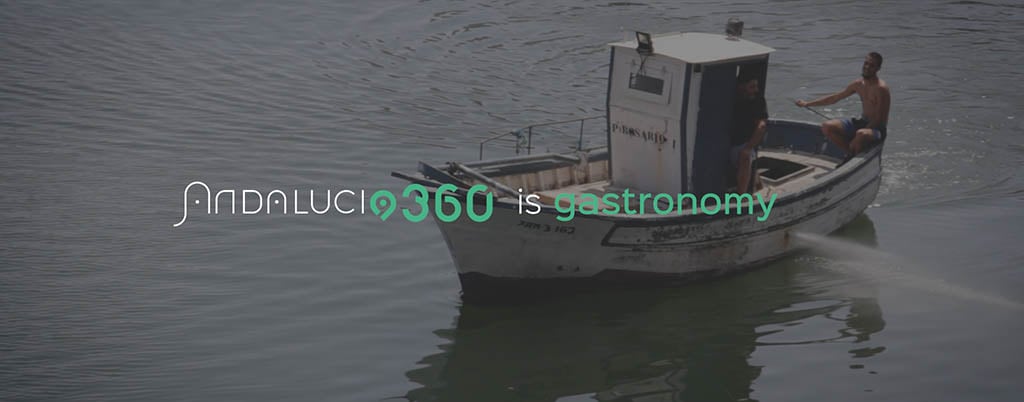Almería has been designated as the “Spanish Capital of Gastronomy 2019”. Find out why and discover some of its most original recipes.
Flavours of Almeria
The gastronomy of Almería is original, very natural and with strong contrasts. In this post you will learn all you need to know to enjoy Almeria’s own products and typical Almerian food. We also have other very complete posts about the gastronomy of Granada, Malaga, Huelva, and Cadiz.
What you will find here
Why is the food of Almeria so original?
Almeria’s gastronomy is a clear example of Mediterranean food. However, this Andalusian province moves between the sea and the high mountains. This geographical variety causes strong contrasts that condition its products and recipes.
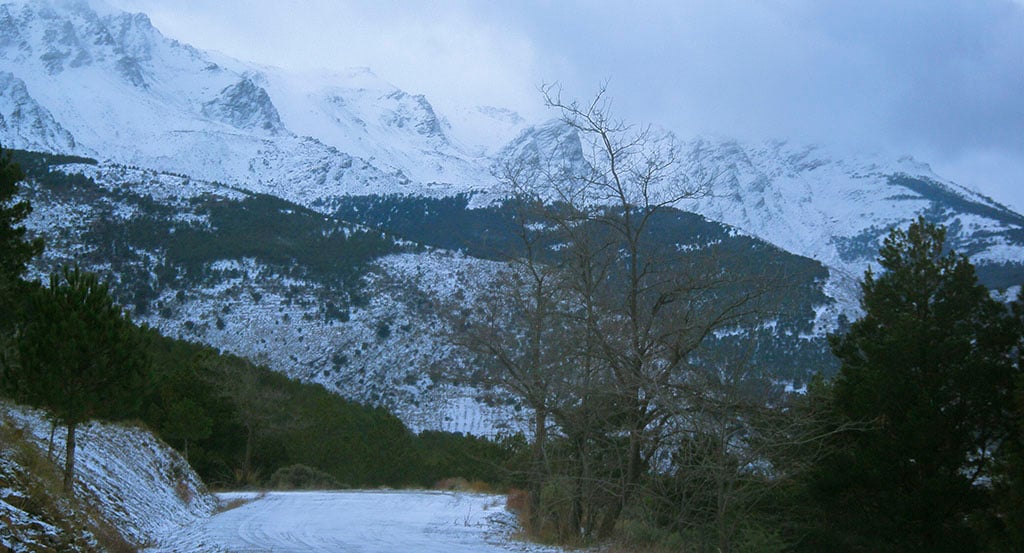
North face of Sierra Nevada. This winter landscape conditions the crops of the valley of the Nacimiento River.
Almería, in general, is an arid land both in its coast and in a large part of its interior. Dry crops such as olive and almond trees dominate the landscape. Other areas, such as the Andarax valley, the north face of the Sierra Nevada or some areas of the Filabres, are somewhat more humid and favour other types of crops.
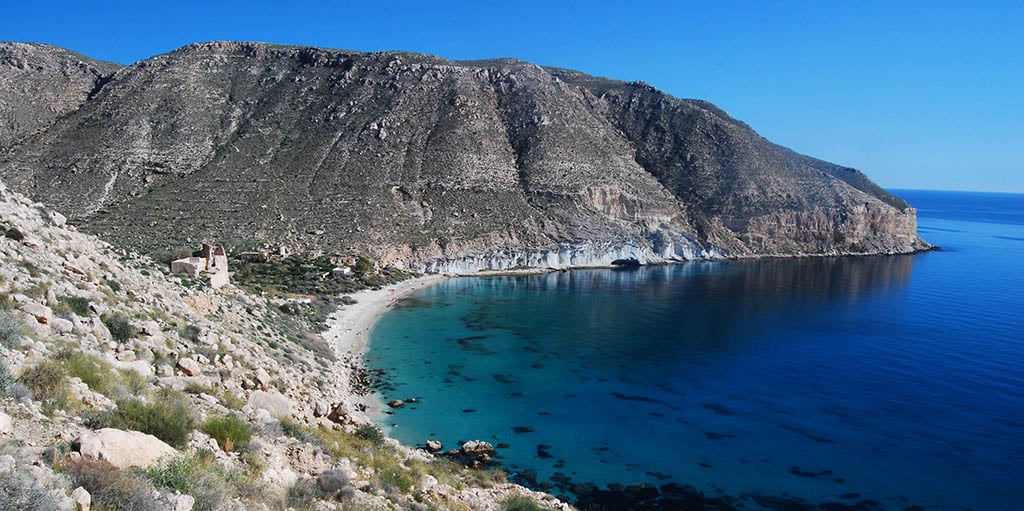
And from the high mountains to the Mediterranean coasts. This is the famous Cala de San Pedro, near Las Negras.
In Almería the sun shines 95% of the days of the year. Rain is scarce in this land, which is also hit mainly by easterly winds in summer and westerly winds the rest of the year. This is the reason for areas such as the Tabernas Desert, famous for being a great outdoor film set.
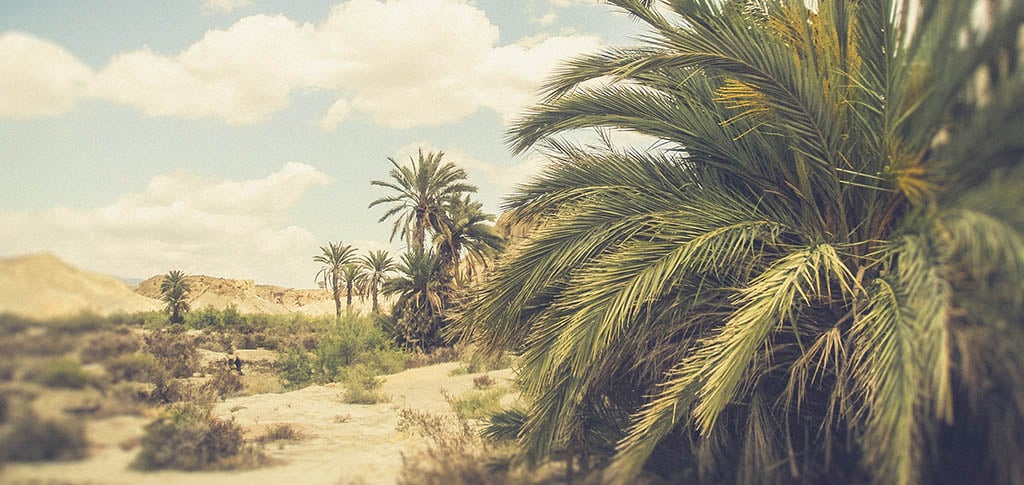
The Tabernas Desert is another of the great geographic conditioning factors of the province.
Almería is a mountainous territory located in the extreme southeast of the Iberian Peninsula. The province is criss-crossed by mountain ranges inland (Alhamilla, Gádor, Nevada, Filabres, María, Estancias) and along the coast (Contraviesa, Almagrera, Cabrera, Cabo de Gata). Geography was once an impediment to the economic development of the capital.
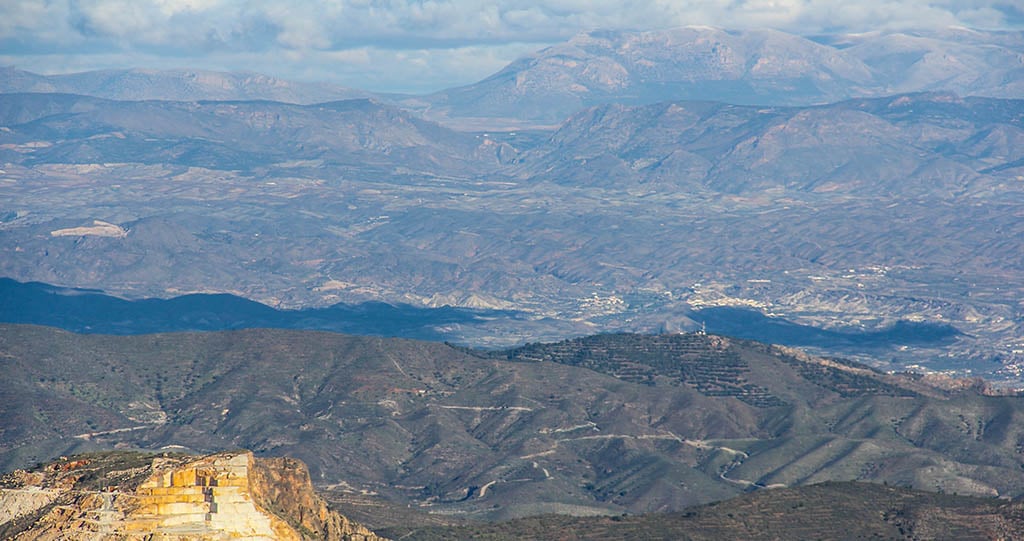
Almería is crossed by continuous mountain ranges from east to west. From bottom to top: last foothills of the Filabres with the marble quarries of Macael; valley of the Andarax; sierra de las Estancias; and finally Sierra de María.
The scarce historical economic development of the area is also evident in the traditional Almerian cuisine. The dishes are made from local products, cheap and easy to obtain. Potatoes, wheat (in grain or prepared with flour), peppers and fish have been the main protagonists.
Another of the main conditioning factors of Almeria’s gastronomy is the Andalusian culture that inhabited these lands for more than 7 centuries. The Muslims brought new products (aubergines, cane sugar, oranges, lemons and melons among others) and developed with great force the cultivation of irrigated and vegetable gardens. The importance of the Roman cereal culture is equally important and valuable, as well as the arrival of new species from 1492 due to the permanent contact with America.
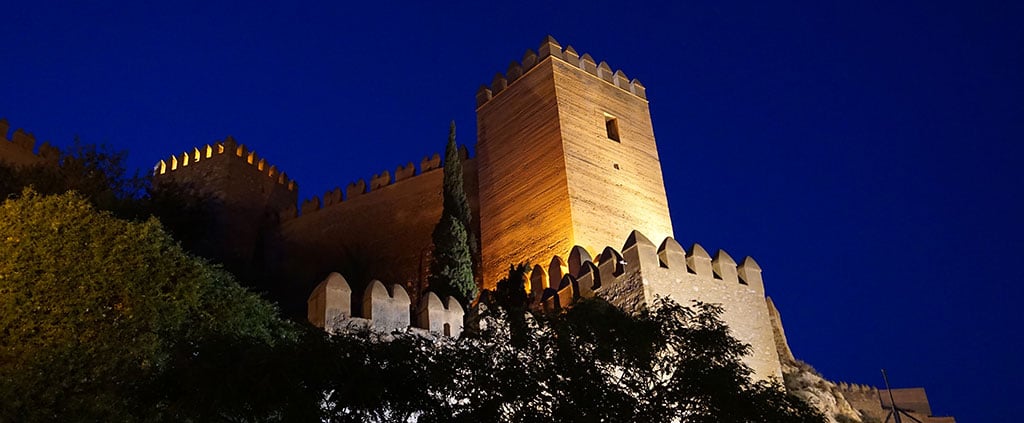
The Alcazaba dominates the whole city and is the most important monument of the medieval Almería (Matt Kieffer. Flickr. CC BY-SA 2.0)
Andalusia is very extensive, and therefore disparate from east to west. In fact, Almeria’s culture is in many ways (speech, traditional music) closer to that of Murcia than to that of Western Andalusia. In the gastronomy you will notice it in some typical dishes such as “arroz y pavo” or “arroz a banda”.
The raw material
FOR DRYLAND
The table grape was one of the main assets of Almería. Thousands of ships set sail from the port of the capital to take Almeria grapes to a large part of the world. Sultanas and mistela are two products made from grapes that are well worth tasting. In the 1970s, there was a profound change in the production system in Almería, which has been maintained to the present day and which gave way to the arrival of greenhouse cultivation. However, grape growing is making a comeback in the province, although it is now destined for wine production. Some of the most interesting wineries are in Laujar de Andarax and Fondón.
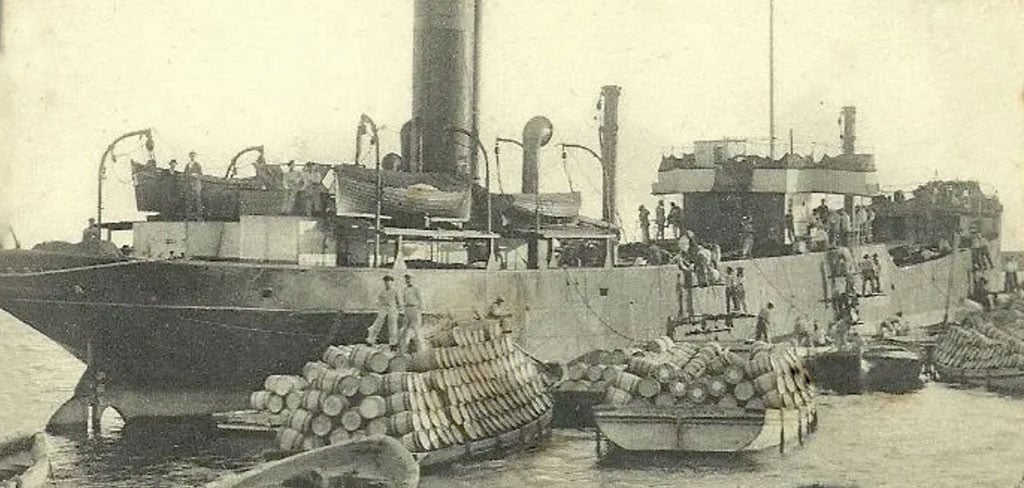
Image of the 1920s or 1930s in the port of Almería. This ship was loaded almost exclusively with drums of table grapes.
The potato is and has been one of the main food sources. Its low maintenance, high production and low production costs have allowed it to survive for generations. It is very present in the recipes of Almería, as we will see later on. The potato is one of those products that arrived in Spain from America after 1492.
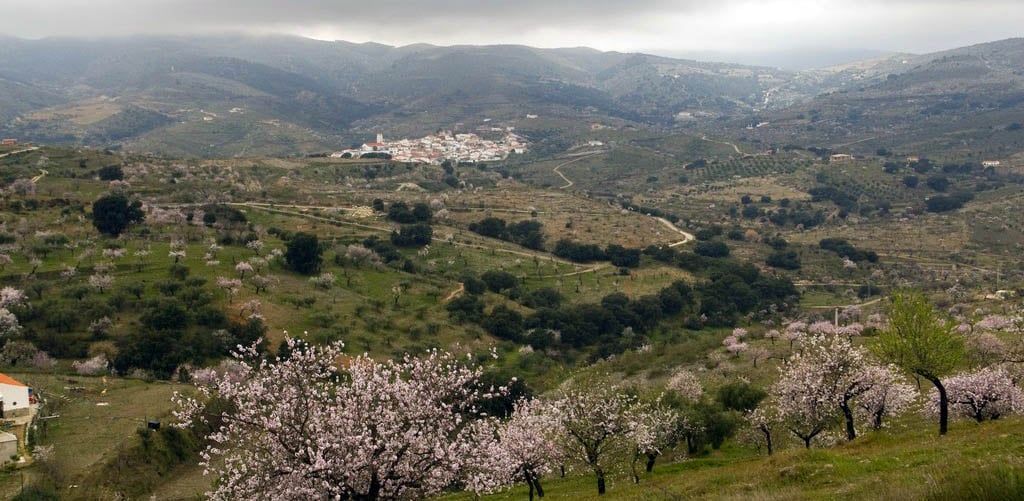
Paisaje de Tahal con almendros en flor (Juan Carlos Cazalla Montijano. Activos Digitales IAPH. CC BY-NC-SA 3.0)
The almond is a hallmark of Almería. It is used as a complement in many recipes, but perhaps the ajo blanco is the most unique (see below). It is a hard nut, but with an extremely delicate formation process. The almond blossom is born in winter. Late frosts and droughts have a negative effect on production in Almeria and increase the price of this product. In recent years new, more cold-resistant species have been introduced. From here it is exported to the national market, but also to countries such as France, Italy and Germany.
The olivo is one of the most widespread crops in Andalusia. And in Almeria it is not far behind. The oil is used in 99% of the recipes. The olives are consumed daily pickled with a wide variety of dressings. The oils from Tabernas (a desert area) have acquired an important fame, but there are also oil mills all over the province, all of them with an excellent product. The oil from Canjáyar, Purchena, Lubrin and Albox has an excellent reputation.
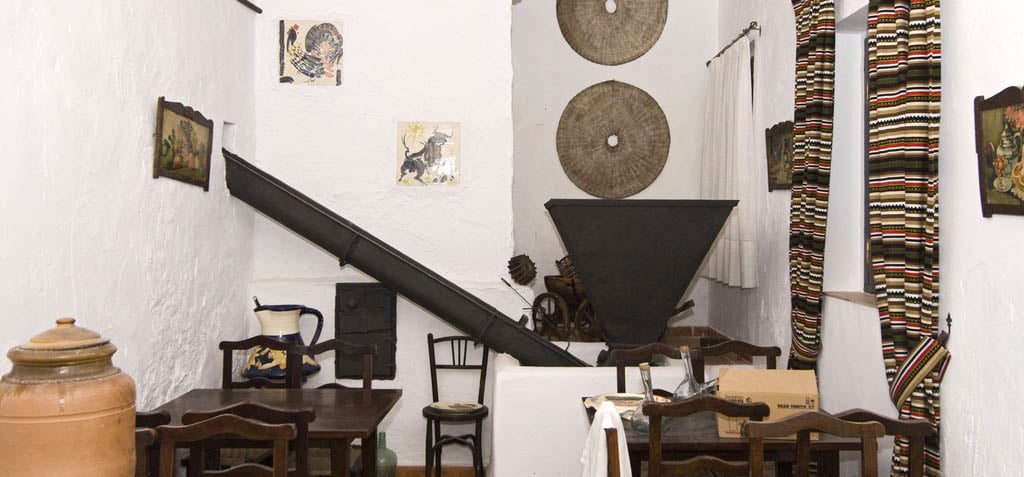
Interior of an old oil mill in Sorbas (Juan Carlos Cazalla Montijano. Activos Digitales IAPH. CC BY-NC-SA 3.0).
The prickly pears. Prickly pears do not need irrigation and are usually associated with farmhouses. They are often found on hillsides or terraces because they help to support the soil. They are eaten raw, but they are also used to make liqueurs, jams, cakes and even ice cream. Yes, prickly pears can be found in many places, but in Almeria they were consumed more abundantly. Although nowadays it is not so prestigious, it is still consumed. Moreover, this plant has been affected in the last few years by a cochineal plague that is reducing its presence in Almeria and other parts of Andalusia.
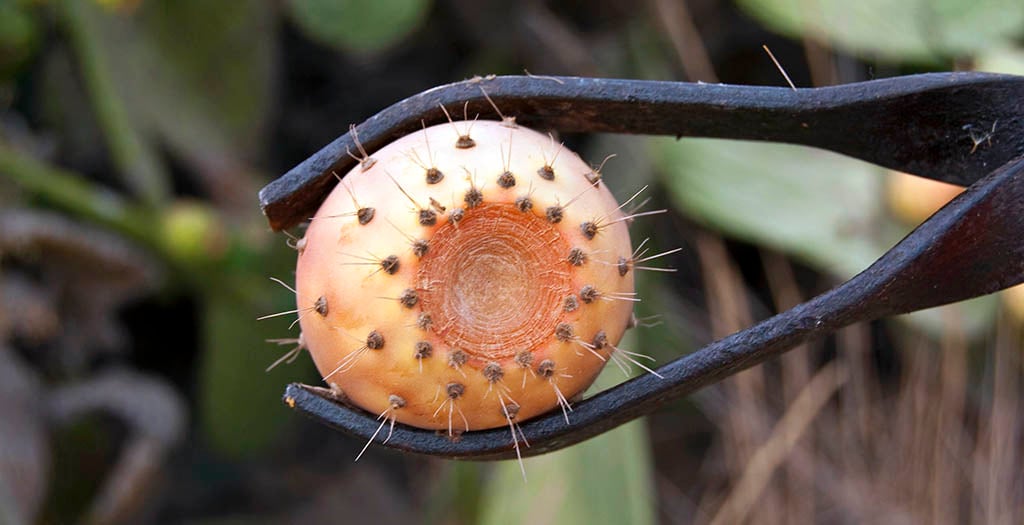
The prickly pears are picked with tweezers to avoid punctures (García Muñoz, Ana Belén. Activos Digitales IAPH. CC BY-NC-SA 3.0)
From the Orchard
Although water is scarce in Almería, market gardens have always existed in the rural areas and around the capital. The warm climate and the large number of sunny days favours the cultivation of tomatoes, aubergines, courgettes, chard, spinach, cucumbers, melons and watermelons. From the 70’s and 80’s onwards, the greenhouses grew with overproduction and variation of species, but this is not the subject of this article.
The vegetable garden is supplied with water by a system of irrigation ditches (water channels). This system was developed with extraordinary skill during the Middle Ages when a series of irrigation shifts were arranged for each plot. In many places this system is still in use today.
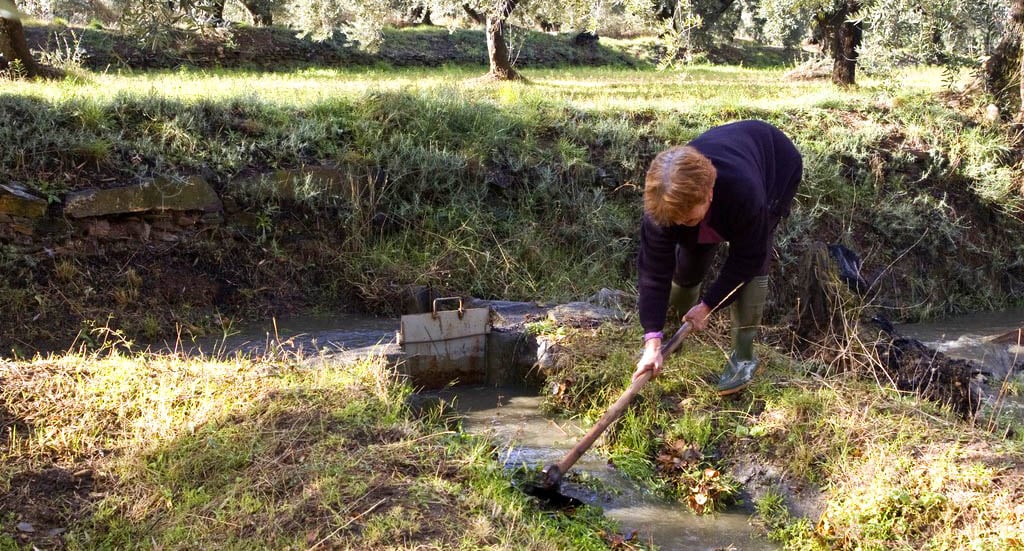
Hoe in hand to clean the irrigation ditches in the Filabres, a 100% sustainable system (Ramírez Guerra, Elena. Activos Digitales IAPH. CC BY-NC-SA 3.0)
The pepper is one of the main protagonists. The possibility of drying it and preserving it for long periods of time has led to its use. It is rare to find a recipe from Almeria that does not include fresh or dried peppers.
The oranges, especially grown in the Andarax river basin near Almeria, are of exceptional quality. In recent years, an Orange Festival has been held in the town of Gádor. During the festival, a tap is set up from which all those attending can drink orange juice free of charge. Remember that some citrus fruits such as oranges and lemons were introduced by the Muslims in the Middle Ages.
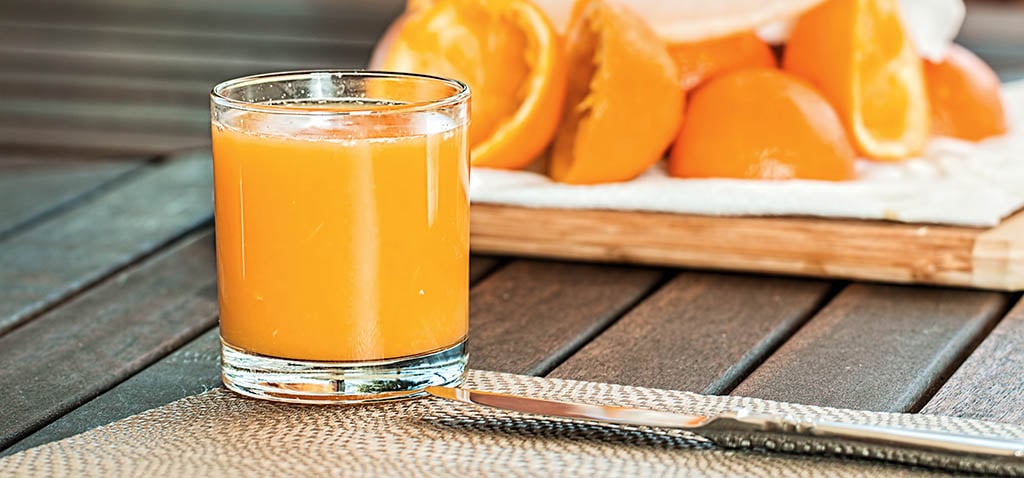
Besides in juices, the orange is present in some recipes of the most innovative restaurants.
From the Sea
The same seafood products typical of the Mediterranean (monkfish, mackerel, red mullet, squid, cuttlefish, shrimp, etc.) are consumed almost everywhere in Andalusia. In Almeria, the most commonly consumed are horse mackerel, sardines, octopus, bonito, tuna and frigate tuna. But here are some others that are much appreciated and less known by visitors.
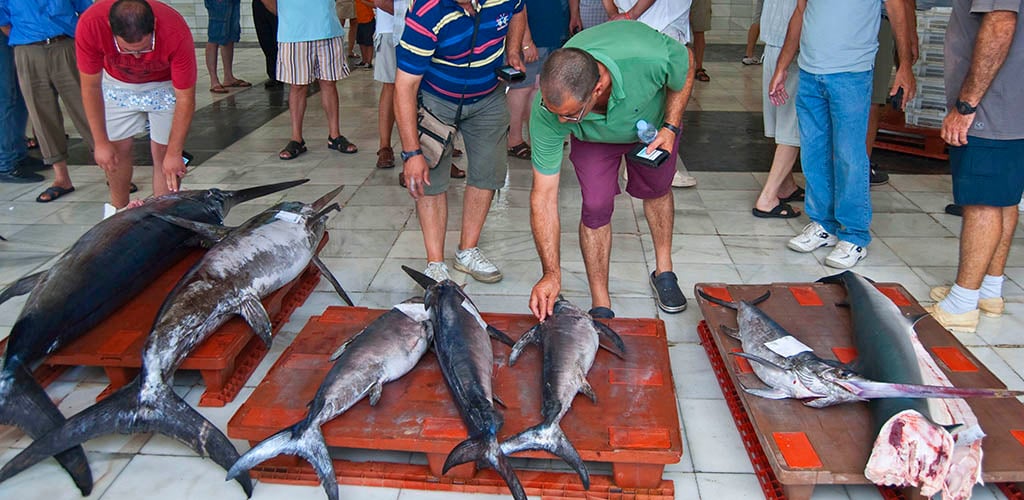
Fish auction in the fish market of Garrucha (García Muñoz, Ana Belén. Activos Digitales IAPH. CC BY-NC-SA 3.0)
The galans are very famous, although they are scarce and their price is high. They are only found in season (July to December) and especially here in Almeria. It is a small fish (10 to 17 cm.) with red scales, white flesh, bulging eyes and very tasty. It is also known as lorito and is usually served fried. Its gelatinous skin when raw and crunchy when fried is one of its most valued aspects. As a curiosity, it is a hermaphrodite fish, it is born female and as it grows it changes its colour and becomes male.
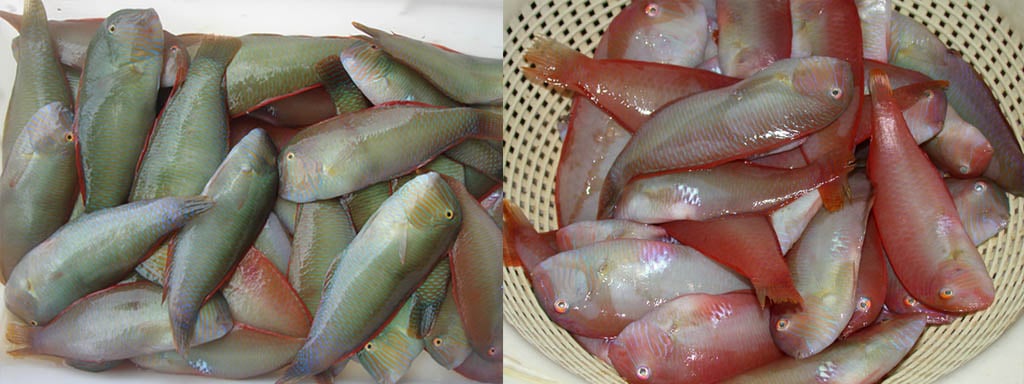
Galanes de Garrucha in the Restaurant Almejero (A. M. Arias. Ictioterm, CSIC. CC BY-NC-ND 3.0 EN)
The Gallopedro not only does it have a unique name, so does its appearance. If you see it before cooking it, you probably won’t feel like eating it, but the key is in its flavour. Outside Almeria you will find it in trendy restaurants and elaborate recipes, but here it is usually eaten fried or grilled.
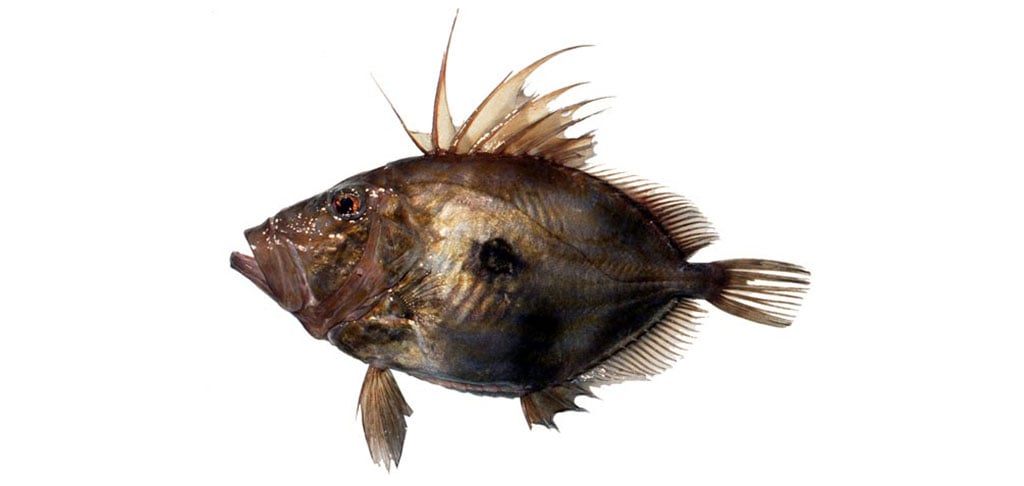
This is the Gallo Pedro, a curious but delicious fish (A. M. Arias. Ictioterm, CSIC. CC BY-NC-ND 3.0 EN)
The red shrimp from Garrucha competes with the one from Huelva. It reaches really exorbitant prices. The fishing ground is small and is limited to part of the coastline of the town of Garrucha. You will find them in many establishments in Almería and the province, but nowhere like in Garrucha.
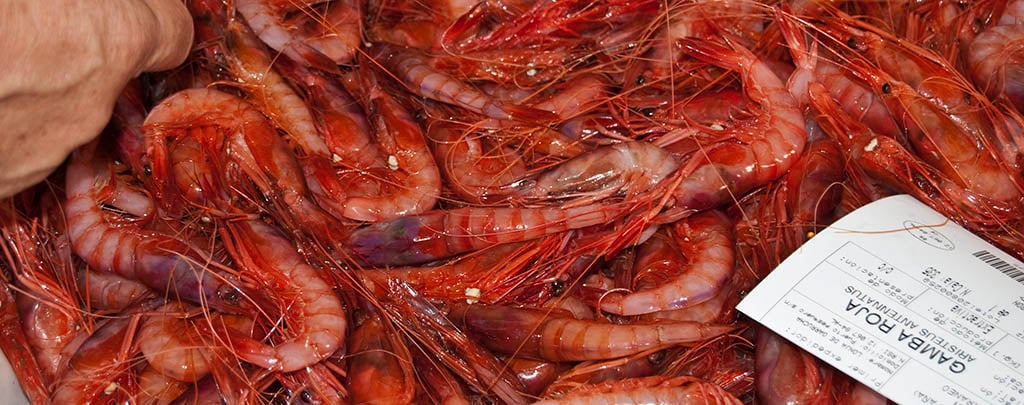
Auction of the red shrimp of Garrucha (García Muñoz, Ana Belén. Activos Digitales IAPH. CC BY-NC-SA 3.0)
The squid are highly prized and abundant. Although they are common in all seas, in the breeding season the Bay of Almeria can become a real hotbed of this cephalopod, being quite easy to catch. Its consumption is more than common both in restaurants and in the homes of the people of Almeria.
Polliquids, pijotas, forkbeards, red mullet, anchovies, etc. make up the fresh fish of Almeria.
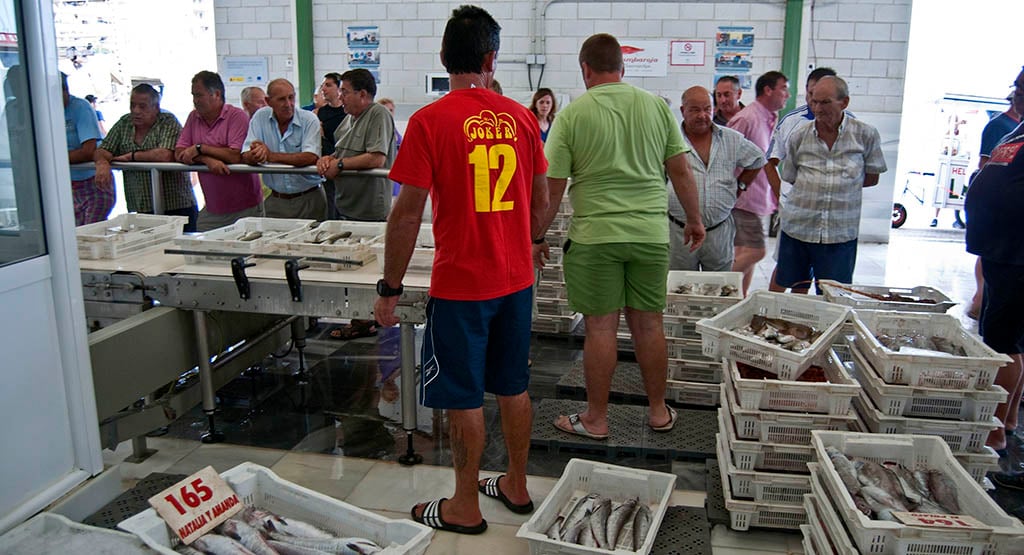
Auction of the red shrimp of Garrucha (García Muñoz, Ana Belén. Activos Digitales IAPH. CC BY-NC-SA 3.0)
CHEESE
There is not much pasture here, so cow’s cheese is non-existent. However, the Almerian landscapes have always been roamed by herds of sheep and goats that feed on the scrub vegetation.
Goat cheese has fewer calories than cow’s cheese, is easier to digest and provides more protein and calcium. However, we prefer these cheeses because of their dry texture, their powerful flavours and the greater naturalness of their production.
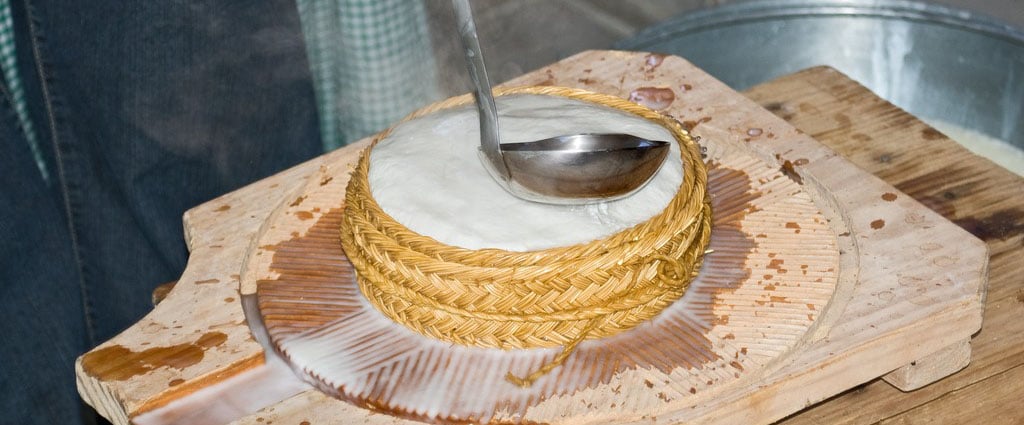
Preparation of artisan cheese in Lubrín, Almería (Ramírez Guerra, Elena. Activos Digitales IAPH. CC BY-NC-SA 3.0).
We recommend several that we have tried, that we have fallen in love with and that are a guarantee of quality. But don’t stop looking for new cheeses, especially from rural areas such as the Alpujarra in Almeria, where tradition is deeply rooted and there are many surprises in store. Spanish cheeses
Queso Seronés. Of course, artisan, made by hand. It won the bronze medal in the category of raw milk cured cheese at the prestigious World Cheese Awards, the Oscars of cheese. In the following video he tells you how Serón cheeses are made.
Quesos Monteagud. This small cheese factory in Uleila del Campo produces some of its 100% artisan cheeses. We recommend the pure goat cheese and the fresh ones.
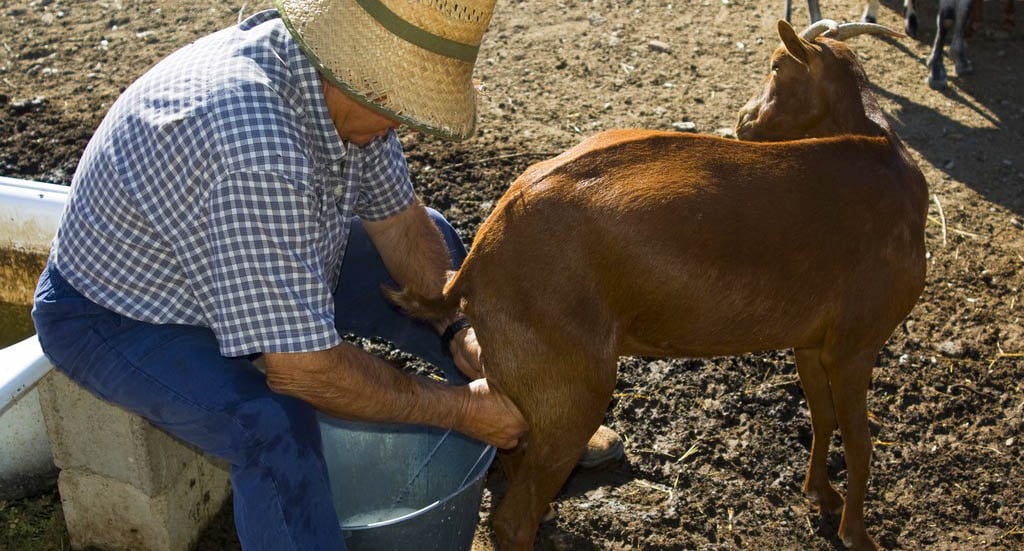
Milking goats in Gérgal, Almería (Ramírez Guerra, Elena. Activos Digitales IAPH. CC BY-NC-SA 3.0).
El Pericho. This is another of Almeria’s family-run artisan cheese dairies. It is located in Roquetas de Mar and is characterised by its extraordinary variety of cheeses.
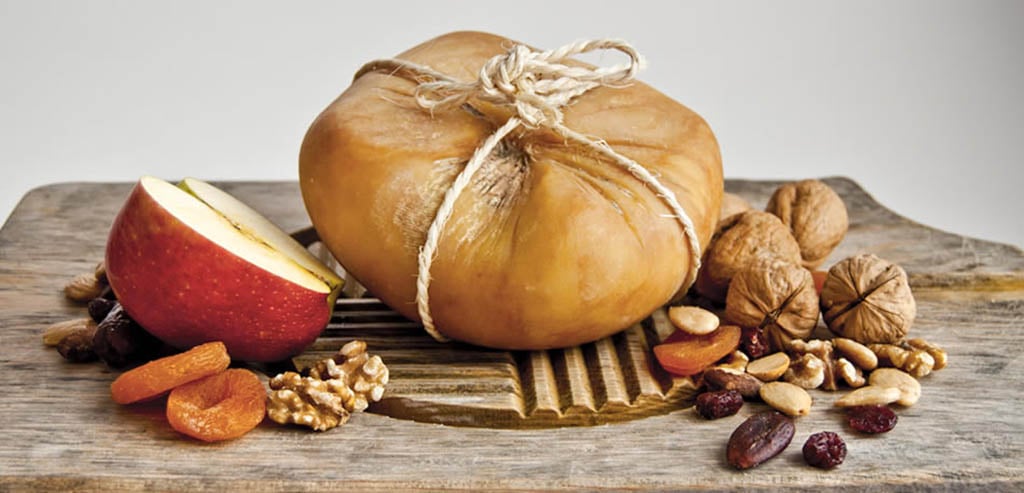
Goat napkin cheese from El Pericho.
PRIVATE TOURS OF ALMERIA
TO SAVOUR IT INTENSELY
The typical dishes of Almeria
Pottages that combine the flavours of the sea and the land are one of the main attractions of Almeria’s cuisine. However, international cuisine is gaining ground, as is the case almost everywhere in the globalised world. Although the tapas in some bars remain faithful to the customs, it is no longer so easy to find good restaurants serving traditional stews.
DEL MAR (SEAFOOD STEWNS AND OTHERS)
As in the rest of the Andalusian Mediterranean coast, Almeria’s cuisine stands out for the preparation of grilled fish. However, we would like to highlight some of the fish and seafood stews that best characterise this province.
Caldo de pimentón. This is a hot fish soup with potatoes cooked in brine and peppers. Small fish such as mackerel, horse mackerel, sardines or anchovies are used. A seasoning or mash of garlic, roasted red pepper, cumin and paprika is added, which adds a lot of flavour and colour. It is cheap to prepare and was common among the less well-off classes in times of famine, especially among fishermen. It is also known by other names such as caldo colorao or gachas en caldo de pimentón. Nowadays the dish has evolved and is made with more expensive fish such as skate. In the following video you have .
Seafood casserole. This stew combines a large quantity of fish and seafood cooked slowly and in their juices. The raw material varies according to the season, so it is common to find it with different fish depending on the time of the year when it is eaten. The sauce can have different ingredients, but it cannot be without breadcrumbs or nuts such as hazelnuts or almonds. .
Gurullos with cuttlefish. Gurullos are a type of pasta made mainly with flour and water. In Almería there are several recipes for gurullos. The oldest ones with rabbit or hare, but combined with cuttlefish it is one of the most original dishes. The gurullos require patience, because after kneading and kneading them, they are made into strips from which the gurullo is removed one by one. After one or two days of baking, they are ready to be cooked. Like almost all Almerian recipes, it has pepper, tomato and garlic.
Marraná de pulpo (Octopus). Don’t let the name put you off, this is one of the must-try dishes of Almería. The recipe includes several alcoholic drinks such as brandy and white wine. Everything is put into the pot at the same time: onion, tomato, bay leaf, pepper, a head of garlic, oil and salt. When the sauce is flambéed and reduced, the flavour is extraordinarily potent. It is a 100% original and traditional dish from Almería which, in recent years, is being revived and becoming fashionable even in tapas bars.
Dried octopus. Another classic dish from Almeria and much of eastern Spain. In the past, octopus was not so popular and was usually eaten in the homes of the fishermen themselves. In fact, dried octopus was a good food to eat at sea due to its long shelf life. Today, prices are quite high because it is considered a delicacy and because it loses up to 75% of its weight during the drying process. After drying, it is usually eaten baked or grilled.
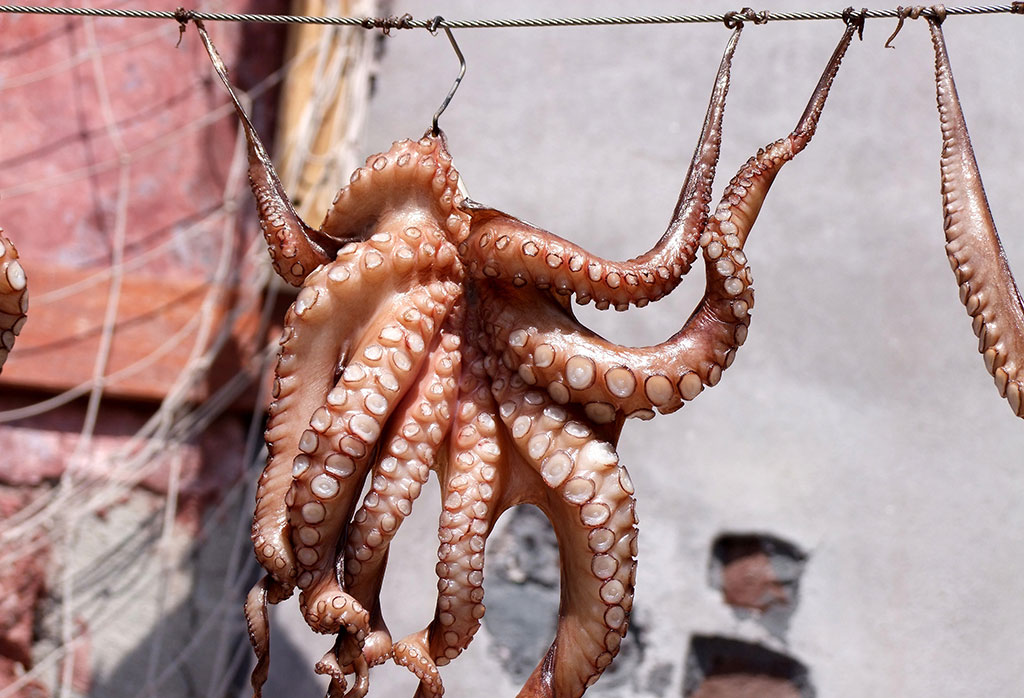
In the traditional process, the octopus was dried in the sun.
The “salazones” are a well rooted custom in this land. The place names of “la Chanca” in the capital or “Almadraba de Monteleva” in Cabo de Gata bear witness to the seafaring craft activity. One of the most typical products are sardines in herring, also called “de cuba” because of the wooden container in which they are preserved. It is a fish preserved in salt with a very strong flavour.

Sardine vat in the Central Market of Almeria (© Turismo Andaluz S.A. www.andalucia.org)
OF THE LAND (TYPICAL DISHES)
We can’t explain all the typical dishes of Almeria, as we would have a real encyclopaedia. Here are some of the ones we have tried and like the most.
Balls stew. Pellets are meatballs in Almeria. This stew becomes more appetising when the cold weather starts to arrive. It is made by combining legumes such as beans with meat in the form of meatballs. The meatballs are a mass of meat cooked and minced with mainly corn flour and to a lesser extent wheat flour. The balls are seasoned with garlic, onion and parsley. It is a very common dish in the Levante area, north of the province and the Filabres.
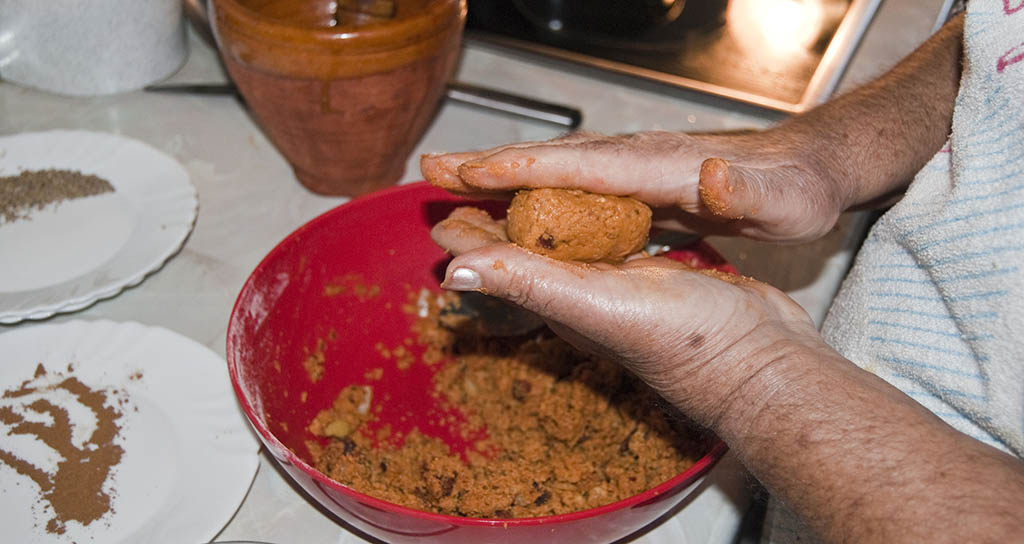
Making the balls in Pulpí, Almería (García Muñoz, Ana Belén. Activos Digitales IAPH. CC BY-NC-SA 3.0).
Masa rallá. This is one of those Almerian recipes with plenty of peppers, as is customary in this region. It is a hearty stew related to porridge, as its broth is thickened with flour. It is known by this name in the region of Los Vélez. Similar recipes can be found in other parts of the province under other names.
White garlic. This is another of those dishes of humble origin with local products that are easy to obtain, but with a unique flavour. A dense spreadable sauce similar to hummus is made from almonds, garlic and oil. Its thick texture is precisely what differentiates it from the ajoblanco of other Andalusian regions, where it is a cold soup accompanied by sweet flavours, such as chunks of melon or grapes. ajo blanco de Almería is a unique dish that can be found as a tapa in some bars, but it is different from the gastronomy of Malaga.
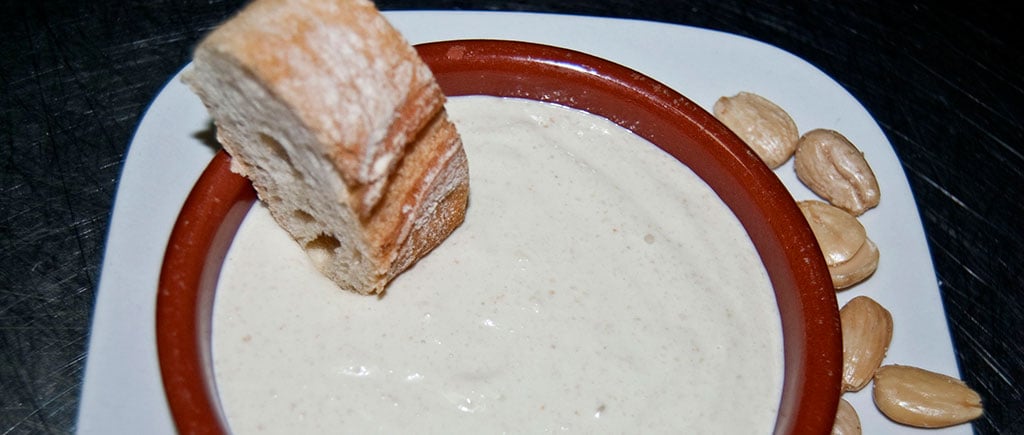
Ajo blanco prepared by a neighbour from Rioja, Almería (García Muñoz, Ana Belén. Activos Digitales IAPH. CC BY-NC-SA 3.0).
Migas. It is a classic among classics. In Almería it rains very little, but as soon as the sky is covered, the people of Almería say “Today migas! In the interior of the province they are made with strong flour, and a little candeal. Nowadays, in order to make them easier to make, they are made with a little corn flour. This is not a food exclusive to Almería. Here it is usually accompanied by sardines in herring, grilled sardines, peppers and melon; or with chorizo, black pudding and torreznos (bacon). It was once a humble meal, as it was made with stale bread left over from months before.
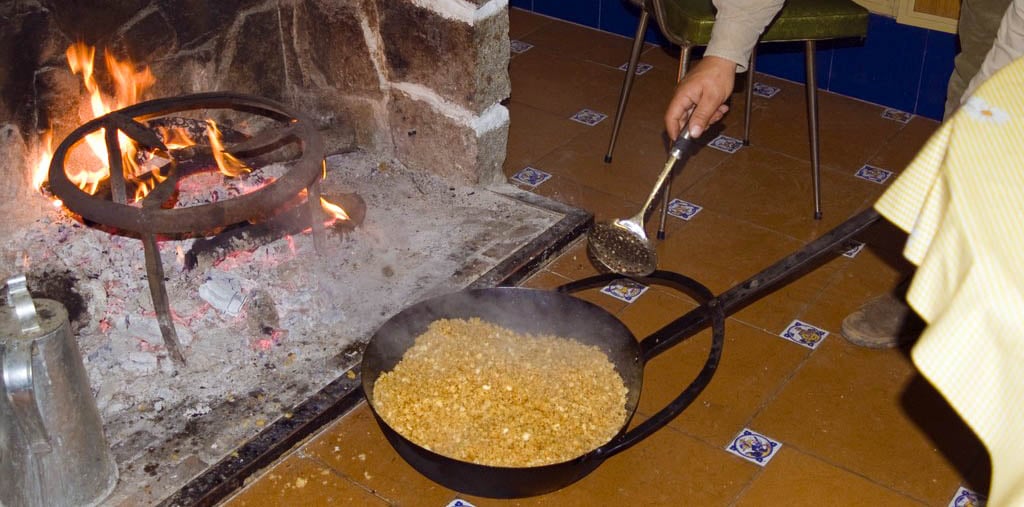
Preparing migas in Gádor, Almería (García Muñoz, Ana Belén. Activos Digitales IAPH. CC BY-NC-SA 3.0).
Wheat stew. This stew is one of the star dishes of Almeria’s gastronomy. It is customary for people from the capital to go up to Felix (a nearby village in the Sierra de Gádor) to have a “Trigo”. And they prepare it marvellously there. Although nowadays there is an abundance of meat in the pot, the original recipe must not have been so generous with it, as Almería was almost always a poor land. It is also called “Olla de trigo con hinojos” (pot of wheat with fennel) because of one of its ingredients, or “San Antón” pot because of its popularity on the day of Antonio Abad (17th January). If you visit Almería in winter, be sure to try it.
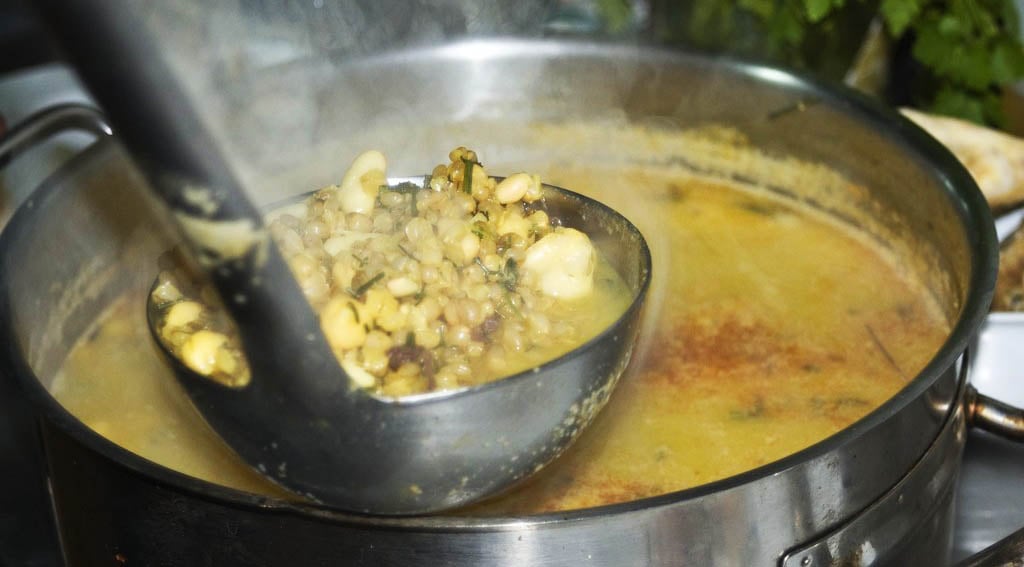
Serving the wheat pot in Gérgal, Almería (Ramírez Guerra, Elena. Activos Digitales IAPH. CC BY-NC-SA 3.0).
OTHER TYPICAL DISHES
And there goes a whole list of typical dishes from Almería. If you see them on the menu you should try them.
Gurullos. Winter stew with many variations based on semolina dough.
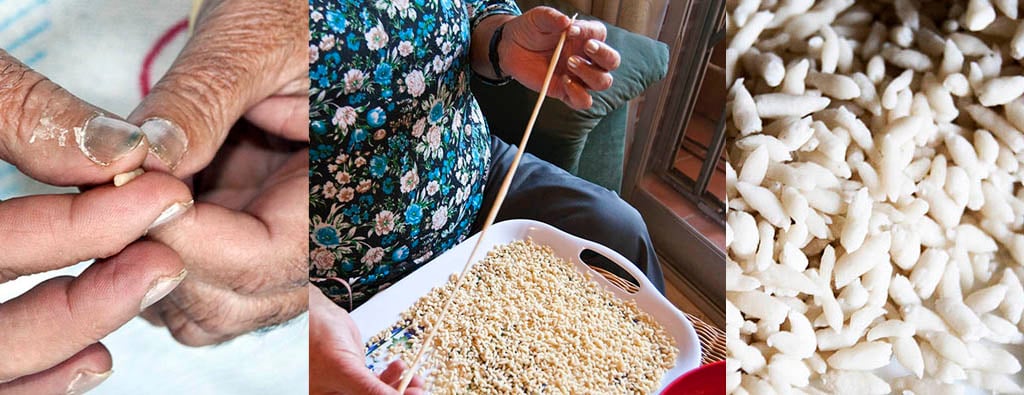
Making the gurullos in Pulpí, Almeria (García Muñoz, Ana Belén. Activos Digitales IAPH. CC BY-NC-SA 3.0).
Atascaburras. A dish made with potatoes and dried peppers, with the addition of cod in some places. .
Rice and Turkey. A unique rice dish, with few ingredients and typical of Vélez and neighbouring Murcia.
Sopa Moruna. Soup of vegetables, minced meat and pulses related to Moroccan harira.
Tabernero. Hot ratatouille with chunks of meat among its ingredients. .
Gachas tortas. Stew of potatoes, flour cakes and various types of peppers and other vegetables.
Patatas a lo pobre. A classic dish from Almeria and almost all of Andalusia. They should be accompanied by some good green peppers.
Acelgas esparragás. This is a vegetable and chard stew seasoned with almonds, garlic, bread and cumin. A real winter and mid-season delight.
Zaramandoña. Typical ratatouille from Fiñana with a base of pumpkin, dried peppers, tomato, olives and cod.
Tortilla de Présules. This is a very typical pea omelette from Dalías. Tortilla de Présules .
Chérigan. These very thin, long slices of bread are spread with aioli and accompanied by a variety of delicious toppings. The key is the thinness of the bread and its toasted crunchy crust.
Sweets
And of course, something sweet for dessert. Here are four that are traditional from Almeria.
Tarbinas. This is a kind of sweet porridge. They were widely consumed 50 years ago and are being revived by today’s chefs. As always present almonds, bread, oil….
Alfajores. In Almería there are two varieties. The so-called “de miel”, which is combined with almonds, and the “de almendra”, which has syrup. This sweet between wafers has Arabic origins. In fact, it is very similar to some Moroccan sweets. The dough is made mainly with almonds, potatoes and sugar. The aniseed and lemon zest give it its special flavour. It is usually made in December for Christmas and almost always at home. So it is sometimes difficult to find it in establishments, especially in the capital.
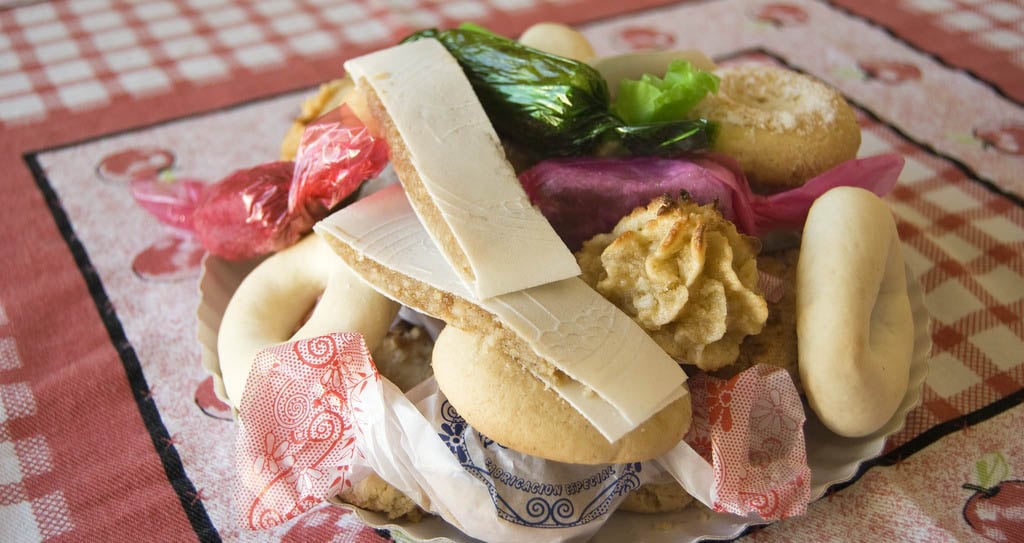
This is the typical dessert dish of the north of Almería at Christmas (Mejías del Río, José Miguel. Activos Digitales IAPH. CC BY-NC-SA 3.0).
Hornazo or hornazo del día de la Vieja. In the east and north of the province, the hornazo is eaten on “Día de la Vieja”, a popular religious festival in the middle of Lent. It is a round or elongated sweet bread. It is characterised by a series of ribbons or braids holding a hard-boiled egg in the centre. Although this curious bread is also common in other provinces of Eastern Andalusia, it is difficult to locate outside of Lent.
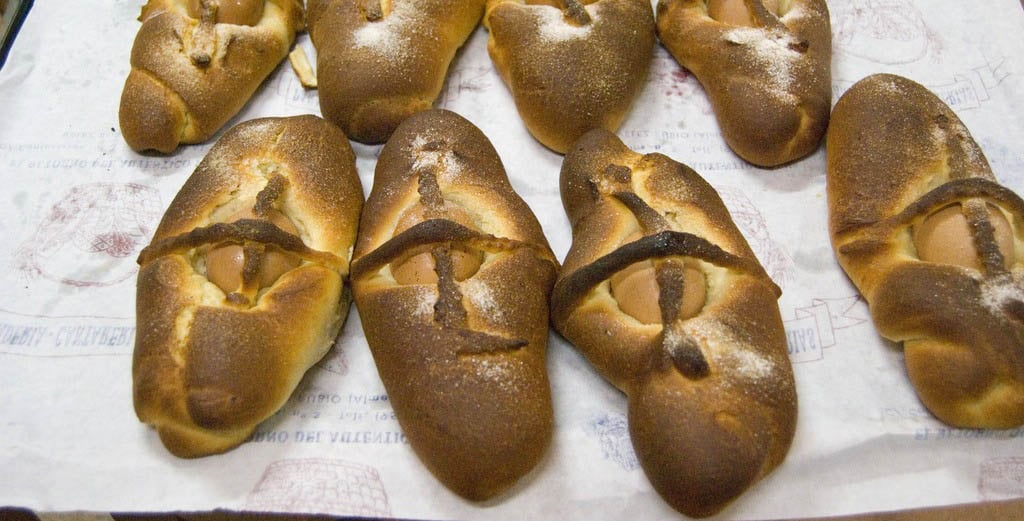
Hornazos of Vélez Rubio (Mejías del Río, José Miguel. Activos Digitales IAPH. CC BY-NC-SA 3.0).
Pan de higo. With a base of dried figs, almonds, aniseed, aniseed, matalauva and orange. This dessert is for those with a sweet tooth, as it is very sweet. Although it is typical of Carnival, nowadays it can be found all year round. Although fig bread can be found in many places in Spain, the one from Almería, and specifically the one from Cuevas, is one of the best.
OTHER SWEETS:
In every village there are traditions of its own, variations of a sponge cake, of some rosquillos. Often these variations are due to the abundance or scarcity of certain ingredients in an area. The sweets can also be associated with popular festivals, mainly religious, others are simply culinary traditions. In Almería you will find buñuelos, borrachillos, papaviejos, tortas de aceite, nochebuenos, leche frita, milhojas alpujarreña, pebetes de calabaza, tortas de chicharrones, soplillos, rosquillos de vino, indalotes, lagrimicas, hojaldres, bizcochos de cabello de ángel and roscos fritos.
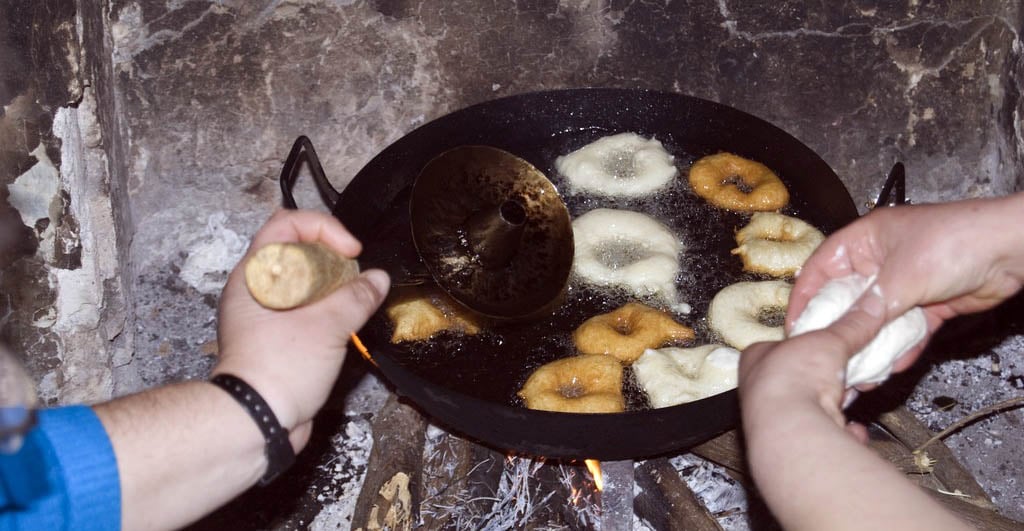
The fritters are fried in plenty of oil. In this image on a wood fire in Ohanes, Almería (García Muñoz, Ana Belén. Activos Digitales IAPH. CC BY-NC-SA 3.0).
Where are we going to eat?
We are going to suggest a few places to try some of the traditional recipes we have mentioned. These restaurants cook mainly with local products and have a popular recognition and special location.
But we will see this in another article. If you want to know 7 places to eat that you can’t miss in Almería, follow the link.

Interior of Casa Puga, one of the most emblematic restaurants in the city (©Turismo Andaluz S.A. www.andalucia.org).
If you go there soon, remember that in most of the bars the drink includes a tapa. And in Almeria you can choose from the menu.
Places of gastronomic interest
Are you going to move around the province of Almeria in search of new flavours? We will soon publish another article with some of the most important and traditional places in the province.
Acknowledgements
As always, this article would be worthless without the help of friends who live in this province and who know the gastronomy better than we do. As well as knowing it, they know where to go to enjoy it on a daily basis. We can say that this post is based on previous documentation, our personal opinion and, above all, the experience of local inhabitants.
Toñi Navarro (Vélez Rubio), Vicente Nzo (Almeria), Whatsapp Group “La Banda del Chandal”, Alberto Arcos (Lúcar), Ana Lentisco (Almeria), To all of them THANK YOU!.

